Molecular Epidemiology of Pneumococci
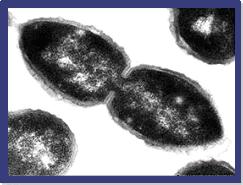 | Adapted from Sá-Leão, R. 2002. Molecular epidemiology of Streptococcus pneumoniae: the contribution of carriers and epidemic clones to the dissemination of antimicrobial resistance. Instituto de Tecnologia Química e Biológica. Universidade Nova de Lisboa, Oeiras, Portugal. ISBN 972-95751-3-4. |
Streptococcus pneumoniae is a major cause of potentially life-threatening infections, for which children of preschool age are at particularly high risk. Because of the high prevalence of respiratory disease and the large number of prescriptions of antimicrobial agents, bacteria colonizing children of day care center age are under extreme antibiotic pressure, and this may be one of the reasons why attendance in day care center is a risk factor for the carriage of antimicrobial-resistant S. pneumoniae.
Our laboratory has been engaged since 1996 in extensive studies aimed to better understand the nasopharyngeal ecosystem and how it is affected by interventions such as antibiotic use and vaccines. Several members of Dr. Sá-Leão’s Laboratory were involved in Projects 1-6 described below.
Since 2011 the work on Pneumococcus is being coordinated by Dr. Raquel Sá-Leão (http://www.itqb.unl.pt/research/biology/molecular-microbiology-of-human-pathogens/molecular-microbiology-human-pathogens).
1. The Lisbon Day Care Center Initiative
Between 1996 and 1999, we performed annual surveillance studies of the nasopharyngeal flora of children attending a group of selected day care centers in Lisbon, with special attention paid to antimicrobial-resistant isolates. We have systematically applied molecular typing techniques in the same day care centers to identify trends in the composition and resistance level of the pneumococcal flora colonizing the nasopharynx (de Lencastre, H. et al., 1999; Sá-Leão, R. et al., 2000; Nunes, S. et al., 2005). Such methods and study design are essential for the understanding of the epidemiological role of day care center in the spread of drug-resistant strains and are also needed in the choice of intervention strategies to decrease carriage of antimicrobial-resistant strains.
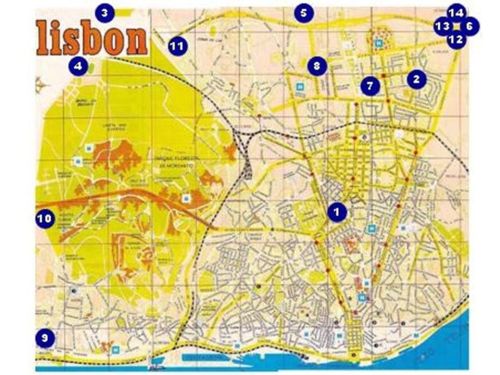 | Figure 1. Adapted from de Lencastre, H., K. Kristinsson, A. Brito-Avô, I. Santos Sanches, R. Sá Leão, J. Saldanha, E. Sigvaldadottir, S. Karlsson, D. Oliveira, R. Mato, M. Aires de Sousa, and A. Tomasz. 1999. Carriage of respiratory tract pathogens and molecular epidemiology of Streptococcus pneumoniae colonization in healthy children attending day care centers in Lisbon, Portugal. Microb. Drug Resist. 5: 19-29. |
In addition, we recently concluded the analysis of a one-year longitudinal study on the dynamics of colonization of pneumococci in the day care center (Sá-Leão, R. et al., 2008). By using serotyping, antibiotyping and DNA fingerprinting techniques, we were able to show that introduction of clones in the day care center occurred during all year and cross-transmission was very frequent as 98% of all strains introduced in the day care center were isolated from at least two children. We found that children were sequentially colonized with up to six pneumococcal clones (mean 3.6) and five serotypes; and attendees, as a whole, provided a pool of hosts where the fittest clones found privileged opportunities to persist and expand.
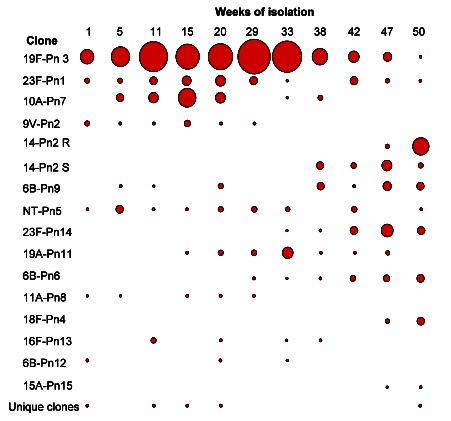 | Figure 2. Temporal patterns of dissemination of pneumococcal clones. Clones defined by serotype and PFGE pattern number. Ex: 19F-Pn3 indicates a pneumococcal isolate of serotype 19F and PFGE pattern 3. The size of the dark circles is proportional to the number of isolates obtained. Unique clones refer to single PFGE patterns. Adapted from Sá Leão, R. et al., 2008. |
2. EURIS - European Resistance Intervention Study |
The Lisbon Day Care Center initiative was extended into a larger context in collaboration with seven international centers as part of the EURIS Project funded by the European Comission. Its main goal was to test several intervention strategies aimed to decrease the carriage of antimicrobial-resistant pneumococci by day-care center attendees. The management of such a large number of data required the development of a web-based infrastructure – EURISWEB – that includes a relational online database, coupled with a query system for data retrieval, and allows integrative storage of demographic, clinical and molecular biology data generated in EURIS (Silva, S. et al., 2003; Mato, R. et al., 2005; Sousa, N. et al., 2005).
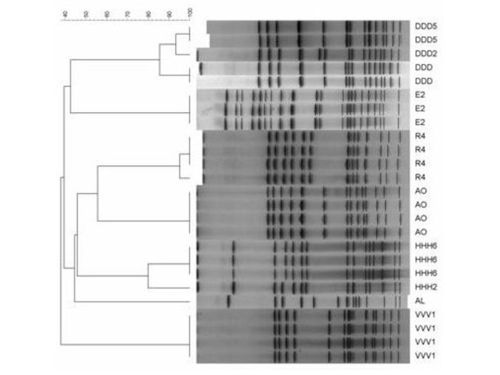 | Figure 3. Adapted from Nunes, S., N.G. Sousa, C. Simas, N. Frazão, R. Mato, I. Santos-Sanches, and H. de Lencastre. 2003. Fluctuation ofStreptococcus pneumoniae major clones colonizing healthy children. Abstract A-38. Micro03'-Congresso Nacional de Microbiologia. Tomar. November 28-December 2, 2003. |
3. PREVIS (Pneumococcal Resistance Epidemicity and Virulence - An Intervention Study) |
|
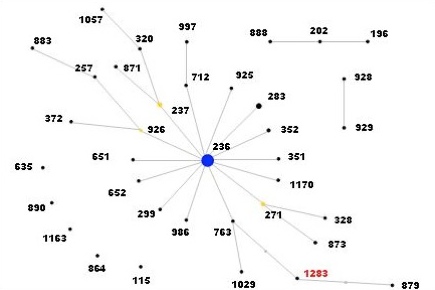 | Figure 4. Adapted from Nunes, S., N.G. Sousa, C. Simas, N. Frazão, R. Mato, I. Santos-Sanches, and H. de Lencastre. 2003. Multilocus sequence typing (MLST) of Streptococcus pneumoniae representative strains of clones colonizing children attending day care centers. Abstract A-39. Micro03' -Congresso Nacional de Microbiologia. Tomar. November 28-December 2, 2003. |
PREVIS was a multinational research effort financed by the European Union project of the 6th Framework Programme that started in early 2004 and finished in June 2007. In this project, the multidisciplinary expertise of fourteen collaborating research centers from Sweden, Portugal, United Kingdom, Iceland, Germany, Czech Republic and USA was deployed to identify bacterial genetic determinants and host factors associated with invasive disease, and spread of epidemic pneumococcal clones.
In parallel with these studies, we described the occurrence of optochin-resistant pneumococci among colonizing isolates (Nunes, S. et al., 2008a). Forty-two (2.1%) optochin resistant strains were detected among a collection of 1,973 isolates. Isolates belonged to serotypes 3, 6B, 10A, 14, 16F, 19F, 20, 23A, and non-typeable. Overall, 86% of the optochin-resistant strains had capsular types not targeted by the 7-valent pneumococcal conjugate vaccine. Most strains had genetic backgrounds also identified among optochin- susceptible pneumococci. Novel optochin-resistant lineages were detected in all years suggesting that, although sporadic, there was a continuous emergence of optochin resistance. This study highlighted that accurate identification of pneumococci is not only important for diagnosis and treatment of infections but also in colonization studies such as those aimed to evaluate the impact of pneumococcal conjugate vaccines.
4. GRACE (Genomics to combat Resistance against Antibiotics in Community-acquired LRTI in Europe) |
GRACE (www.grace-lrti.org) is a Network of Excellence focusing on the complex and controversial field of community-acquired lower respiratory tract infections (CA-LRTI), which is one of the leading reasons for seeking medical care. The promiscuous use of antibiotics to treatment of CA-LRTI accounts for a major part of the community burden of antibiotic use and contributes dramatically to the rising prevalence of resistance among major human pathogens. The overall objective of GRACE is to integrate and coordinate the activities of physicians and scientists from many institutions in 14 European countries to combat antimicrobial resistance through integrating centers of research excellence and exploiting genomics in the investigation of CA-LRTI. Microbial and human genomics will be integrated with health sciences research consisting of clinical observational and intervention studies, health economics and health education to specifically change practice in managing CA-LRTI.
5. Pneumococcal ecology in the era of the seven-valent pneumococcal conjugate vaccine
The seven-valent pneumococcal conjugate vaccine (PCV7) become commercially available in Portugal in June 2001 but as of July 2008 had not been introduced in the national vaccination plan. We have conducted a study to monitor its use and impact on day care center attendees. We found that by 2006, close to 60% of the children participating in our study had been vaccinated with PCV7. Pneumococcal carriage rates remained high (over 60%) and serotype replacement could be observed among vaccinees and non-vaccinees (indirect herd effect). In particular, some rarely carried serotypes such as serotype 1 were detected in increasing abundance (Nunes, S. et al., 2008b). Of interest, antimicrobial resistance rates remained stable. The results on antimicrobial resistance support previous observations made on a prospective study carried out in a small group of day care centers where PCV7 was offered in some day-care centers and colonization patterns were compared to a control group (Frazão, N. et al., 2005).
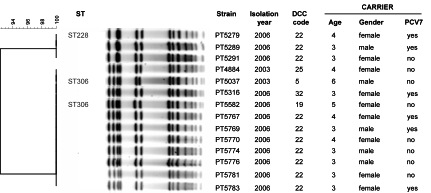 | Figure 5. Genotypic relationship of serotype 1 pneumococcal isolates according to PFGE. ST, sequence type; DCC, day-care center; PCV7, vaccinated with seven-valent pneumococcal conjugate vaccine. Adapted from Nunes, S. et al., 2008b. |
6. PNEUMOPATH (A comprehensive dissection of pneumococcal-host interactions) |
PNEUMOPATH (www2.le.ac.uk/projects/pneumopath/aboutproject) was a multinational research effort financed by the European Union as a project of the 7th Framework Programme that started in early 2009 and finished in August 2012. In this project, the multidisciplinary expertise of sixteen collaborating research centers from the United Kingdom, Sweden, Portugal, Iceland, Germany, France, Austria and the Netherlands was deployed to perform comprehensive study of the host-pathogen interactions during infection with Streptococcus pneumoniae. The work was organized in six scientific workpackages: 1) molecular epidemiology of antibiotic resistant pneumococci; 2) genetic basis of disease susceptibility in the human host and in mice; 3) molecular aspects of virulence and host response in animal models of pneumococcal carriage and disease; 4) molecular aspects of virulence and host response in human cell culture systems; 5) pneumococcal cell biology to determine the role of central metabolic processes and the link to virulence; and 6) integrated bioinformatics and data management. As part of the PNEUMOPATH we were involved in studies aimed to determine the mechanisms responsible for increased invasive disease potential which has been associated to some genetic backgrounds.
7. Bridging Streptococcus pneumoniae epidemiological and animal studies
Colonization of the nasopharynx with S. pneumoniae is a prerequisite to pneumococcal disease. Having conducted the first epidemiological study in Portugal on the impact of the 7-valent pneumococcal conjugate vaccine (PCV7) on colonization, our group showed that PCV7 selected for drug-resistant serotypes (e.g. 6A, 15A and 19A), which replaced previous dominant pneumococci (Frazão, N. et al., 2005). We are currently using murine models to uncover the mechanisms governing the colonization capacity and virulence of the emergent PCV7-selected serotypes.
This work is being performed by Nelson Frazão in collaboration with Alexander Tomasz (The Rockefeller University).
References
Frazão, N., A. Brito-Avô, C. Simas, J. Saldanha, R. Mato, S. Nunes, N.G. Sousa, J.A. Carrico, J.S. Almeida, I. Santos-Sanches, and H. de Lencastre. 2005. Effect of the seven-valent conjugate pneumococcal vaccine on carriage and drug resistance of Streptococcus pneumoniae in healthy children attending day-care centers in Lisbon. Pediatr. Infect. Dis. J. 24:243-252.
Frazão, N, R. Sá-Leão, and H. de Lencastre. 2010. Impact of a single dose of the 7-valent pneumococcal conjugate vaccine on colonization. Vaccine. 28:3445-52.
Tavares, D. A., R. Sá-Leão, M. Miragaia, and H. de Lencastre. 2010. Large screening of CA-MRSA among Staphylococcus aureus colonizing healthy young children in Portugal. BMC Infect Dis. 10:110-8.
Sá-Leão, R., F Pinto, S. Aguiar, S. Nunes S, J. A. Carriço, N. Frazão, N. Gonçalves-Sousa, J. Melo-Cristino, H. de Lencastre, and M. Ramirez. 2011. Analysis of invasiveness of pneumococcal serotypes and clones circulating in Portugal before widespread use of conjugate vaccine reveals heterogeneous behavior of clones expressing the same serotype. J. Clin. Microbiol. 49:1369-75.
Simões, A.S., L. Pereira, S. Nunes, A. Brito-Avô, H. de Lencastre, and R. Sá-Leão. 2011. Clonal evolution leading to maintenance of antibiotic resistance rates among colonizing pneumococci in the PCV7 era in Portugal. J. Clin. Microbiol. 49:2810-7.






